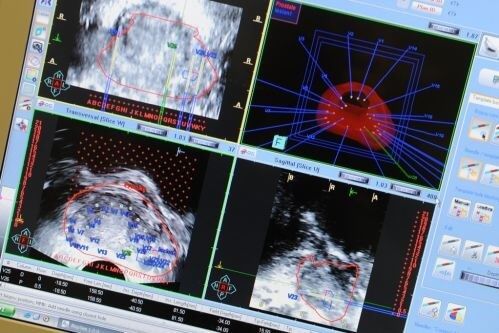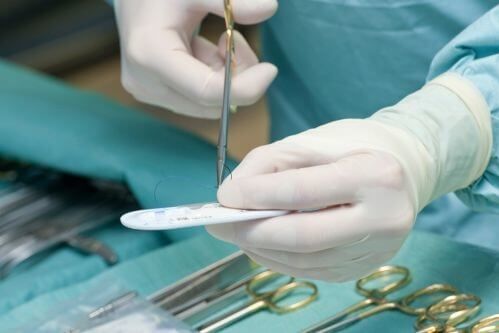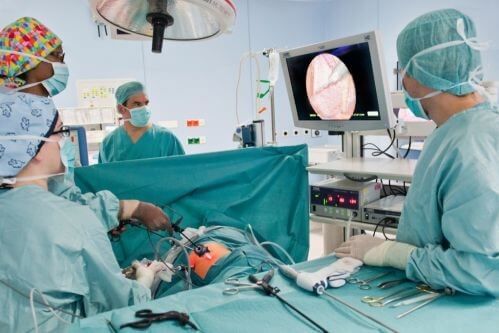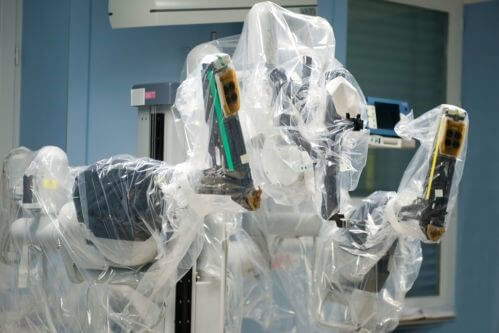Slide show: Treatment of Prostate Cancer
at Heidelberg University Hospital

© Heidelberg University Hospital
Prostate cancer treatment
The Department of Urology at the Heidelberg University hospital is one of the most renowned institutions for the treatment of prostate cancer. Together with his colleagues from the Departments of Radiooncology (HIT; Professor Debus), Oncology (translation; Professor Jäger) and Nuclear medicine (PSMA-Pet; Professor Haberkorn) Professor Hohenfellner and his team diagnose and treat more than 2000 patient with prostate cancer each year.

Diagnosis prostate cancer
A suspicious finding – i.e. an induration of the prostate – in a digital rectal examination and/or an elevated PSA-level can be signs for the presence of prostate cancer. Further steps to confirm the diagnosis should be made.

Prostate Biopsy
Only a biopsy of the prostate – taking small tissue samples – can confirm the diagnosis. Usually twelve random samples are taken from the prostate. However, at the department of Urology in Heidelberg we use modern MRI-guided-fusion biopsy. A MRI scan of the prostate can reveal suspicious lesions within the prostate which are specifically targeted during biopsy to ensure a most accurate diagnosis. During the biopsy live ultrasound images a used for biopsy-needle guidance.

Pathology: Confirmation of diagnosis
The samples taken are sent to the Department of Pathology of Heidelberg University Hospital where expert pathologists analyze the prostate tissue microscopically. Here the diagnosis can be confirmed.

© P. Benjamin
Discussion of treatment options between experts
Once the diagnosis has been confirmed an interdisciplinary team of physicians from various departments discusses which steps should be taken next and which treatment is the best for each individual patient. This is done in a so called “tumor board” at the National Center for Tumor Disease (NCT). The advice given by the round of experts is then further discussed with the patient and a joint decision is made which therapy the patient should receive based on individual needs and risk profile. Depending on different risk factors different treatment options for prostate cancer are possible: active surveillance (low-risk prostate cancer), radical prostatectomy or irradiation. Novel treatment options such as high intensity focused ultrasound (HIFU) are also offered individually or as part of clinical trials.

Prostatectomy
In case the patient decides on having a radical prostatectomy we offer different surgical techniques: open radical prostatectomy, perineal prostatectomy and laparoscopic as well as robotic radical prostatectomy.

Minimally invasive approach
If possible we prefer a minimally invasive approach for the removal of the prostate and lymph node dissection to reduce perioperative morbidity as well as in-hospital stay.

DaVinci system for highest surgical precision
At the Department of Urology at Heidelberg University Hospital we successfully introduced the daVinci system in 2004. The daVinci system offers a very precise and gentle, minimally invasive approach. It provides the surgeon with high-resolution and three-dimensional vision of the operative field making the operative technique even more accurate. The robotic radical prostatectomy has since become a standard of care with excellent oncological as well as functional results.

Radiation Therapy
If a patient needs additional irradiation therapy in case of aggressive disease irradiation therapy is offered at the Department of Radio-Oncology. Professor Debus and his team offer radiation therapy for various clinical demands, for example IMRT or proton therapy.

National Center for Tumor Diseases (NCT) Heidelberg
For patients with advanced tumor stages there are also drug-based treatment options such as androgen deprivation therapy (ADT) and chemotherapy. Professor Jäger and his team of oncologists as well as urologist see patients at the National Center for Tumor Disease (NCT) where patients can receive chemotherapy in a day-clinic setting.

PSMA-PET-CT
Another aspect that makes Heidelberg University hospital stand out is that our research results are quickly introduced into the clinical routine. One prominent example is the PSMA-molecule which specifically binds to prostate cancer cells. It can be used for diagnostic purposes – PSMA-PET-CT – to identify prostate cancer metastases in the entire body as well as for the treatment of very advanced prostate cancer to transport therapeutic radionuclides into the cancerous cell.

Section of Precision Oncology for urological tumors
In especially complex situations our Section of Precision Oncology for urological tumors (Professor A. Duensing) analyses genetic changes in cancer cells and based on those results offer individually tailored treatment.

Close cooperation with researchers
Another aspect which makes the Department of Urology unique is our close cooperation with researchers. At our own research laboratory (Professor S. Duensing) we do not only do basic-research on the genesis and progression of urological tumors but also try to bring the results into the clinical routine in a transitional approach making new concepts as quickly as possible available for our patients.


